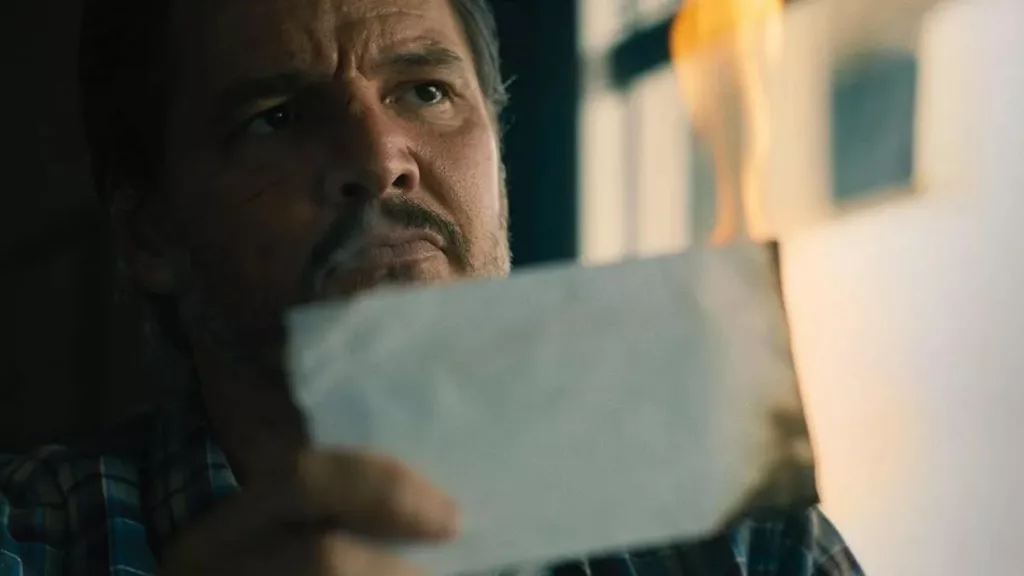Anna Boden and Ryan Fleck kick off their newest flick with an eclectic blast from the past. After making waves in indie cinema with character-driven films like Half Nelson and Mississippi Grind, the directing duo stepped into the blockbuster arena with 2019’s Captain Marvel. Now they return to their artsy roots while retaining some big-budget bravado with Freaky Tales – a rowdy genre mashup fueled by ’80s nostalgia.
Structured as four interconnecting stories à la Pulp Fiction, the movie takes place in 1987 Oakland, where Boden and Fleck pour their heart and soul into recreating the city they know and love. From the punk rock rebels of Gilman Street to legendary basketball star Sleepy Floyd, they pack their ensemble cast of underdogs with real-life local icons and rising stars alike. Their tales get amplified by a mysterious supernatural force (imagine Ghostbusters on steroids) as the characters gear up for bloody battles with villains like Nazi skinheads and corrupt cops.
It’s one hell of a homecoming love letter to a bygone era, where the funky fashion and synth-laden soundtrack will catapult you straight back to the ’80s. But beneath all the gnarlynostalgia and comic book-style action, Oakland remains the real star – with Boden and Fleck spotlighting its underground music scene, sports legends, and subcultures that made the city so freaky…in the best possible way. So lace up your hi-tops and get ready for a gonzo trip down memory lane.
A Rollercoaster Plot Packed With Surprises
Boden and Fleck waste no time jumping right into the action across Freaky Tales’ four wild chapters. An ominous supernatural force dubbed “cosmic green shit” acts as connective tissue, manifesting as glowing eyes or freak lightning storms to link the stories.
First up in “The Gilman Strikes Back,” a ragtag band of punk rockers face off against some nasty Nazi skinheads looking to destroy their safe haven music venue. Mohawked ringleader Tina and her pal Lucid have to defend their community when the bigots attack, unleashing a brutal back-alley brawl straight out of The Warriors.
Chapter two takes a hard left turn, following best friends and aspiring rappers Barbie and Entice (stage name: Danger Zone) as they gear up for a potentially career-making rap battle against Too $hort himself. But some skeevy suits underestimate these girls’ skills, leading to an epic showdown between old school misogyny and new school feminine power.
Just when you think you know where this is headed, Freaky Tales delivers a one-two punch of Pedro Pascal as Clint, a stone cold criminal enforcer looking to escape the game for good in chapter three. Of course, quitting ain’t so easy, and Clint’s “last job” spirals violently out of control right as he’s about to become a new dad.
Finally, the movie caps things off with the unbelievable true story of Golden State Warrior Sleepy Floyd’s record-shattering 51-point underdog victory against the Lakers. But in Freaky Tales’ fictionalized version, his win ends in tragedy, sending Sleepy on a roaring rampage of revenge through the Oakland streets with sword in hand and green fire in his eyes.
With breakneck pacing and colorful characters around every turn, Freaky Tales bucks predictability in favor of keeping viewers on their toes. So strap in tight, because this psycho ride takes some wildly unexpected twists and turns through 1987 Oakland’s gritty yet magical underbelly.
Thematic Homages: Underdogs, Nostalgia, and Mythmaking
At its bleeding heart, Freaky Tales is an unabashed celebration of underdogs and outcasts standing up to oppression and punching down injustice, whether from skinhead punks or slimeball executives. Each chapter finds everyday nobodies and fringe heroes – from teen rappers to sports icons – overcoming the odds with a rocket-powered blend of grit, passion, and supernatural momentum shifts.
Boden and Fleck also pay ecstatic homage to the movies, music, and culture that defined their 1980s childhood. Freaky Tales plays like a greatest hits compilation of the era’s aesthetic, dropping sly references to touchstones like Repo Man, The Lost Boys, and Raising Arizona with glee. Combined with an electrifying hip hop and synth-punk soundtrack, the blast of nostalgia achieves maximum orbit.
Most touchingly, Freaky Tales doubles as a heartfelt tribute to the directors’ sun-soaked hometown, spotlighting Oakland’s vibrance past and present. The film puts the city’s icons like Sleepy Floyd and Too $hort on a pedestal while also probing its underground artists, activists, and instigators who gave Oakland its scrappy character. Reality blends with fiction as Boden and Fleck mythologize the city’s history through a playful superpowered filter.
The film’s genre-scrambling structure reinforces this tug of war between gritty real places and fantastical “what if” scenarios. Moments of stylish, comic book-style ultra-violence clash intriguingly with quiet character-driven drama until the boundaries blur. By the end, Oakland itself seems like the story’s true supernatural force – the roots that ground even its most unhinged flights of fancy.
So while the ass-kicking showdowns steal the spotlight, don’t overlook the heart and soul pulsing through the stitches that holds Freaky Tales together. Because beneath all that green goo may just lie profound stories of ordinary folks made extraordinary through self-actualization. And doesn’t that make Oakland the freakiest place of all?
Electric Ensemble and Slick Production
The engine that powers Freaky Tales’ madcap mayhem is its dynamic ensemble, led by electrifying turns from Jay Ellis and Pedro Pascal alongside explosive breakouts like Normani and Dominique Thorne. Ellis brings both athletic prowess from the court and wounded intensity to his fictionalized chapter as legend Sleepy Floyd. Meanwhile, Pascal flexes slick charisma and kinetic physicality as criminal-with-a-heart Clint, nailing another badass with hidden depths.
Yet the film’s secret weapons are rising superstars Normani and Thorne as rap duo Danger Zone. The longtime friends blast each scene with infectious camaraderie and fierceness, proving the movie’s most engaging chapter. From fending off harassment at their day job to throwing down rhymes on the mic, their star power promises huge things ahead.
Helming all the controlled chaos with vigor, directors Boden and Fleck plus editor Wyatt Smith keep the pace tight as a drum. As chapters overlap and storylines intertwine, they flawlessly bounce between timelines without losing momentum. It’s a balancing act they stick with panache.
The technical craft also dazzles, from cinematographer Jac Fitzgerald’s rich lighting schemes enhanced by color pops of green to Patti Podesta’s transportive production design overstuffed with era-specific texture. Trend-defining costumes, old school practical gore effects, and a soundtrack banging with ‘80s hip hop and punk perfectly complete the aesthetic package.
During fight scenes, stylistic slo-mo kicks, comic book zooms, and exuberant blood sprays express the poetic glory of righteous underdogs scoring vengeance. And subtle aspect ratio shifts from boxy fullscreen to widescreen capture both intimacy and scope.
It all coalesces into an enthusiastically-constructed fever dream. From sound stages to real East Bay locations, Freaky Tales’ technical mastery and performance dynamite provide the perfect playground for Boden and Fleck’s wild Oakland fantasies to run free.
Looking Beyond the Flash for Substance
Behind Freaky Tales’stylish veneer and sensationalized set pieces, richer themes come through in how characters relate to their community. Each chapter introduces underdogs and outcasts with a fire to defend something greater than themselves. Their foes represent oppression and corruption testing those shared values.
Punk sweethearts Tina and Lucid fight for the sanctity of their non-judgemental music scene against violent hatemongers aiming to squelch free expression. The skinheads serve as a foil to principles of acceptance. Meanwhile, aspiring rappers Entice and Barbie channel strength against industry sharks seeking to exploit their talent and curb female empowerment. Together they transform humiliation into righteous fury.
On his quest for reform and fatherhood, Clint walks a tightrope between two worlds, tempted both by criminal brotherhood and responsibility to family. His ambitious kingpin pushes zero-sum power gains, ignoring the collateral damage. But Clint awakens to his ability to break the chain of violence if he stays loyal to deeper human bonds.
Even Sleepy Floyd’s basketball legacy links to overcoming the odds to become a folk hero for Oakland. His fictional face-off against a bigoted cop pits athletic glory against authoritarian cruelty. Their duel symbolizes sports as a vehicle for social mobility and a cry for justice that inspires community solidarity.
Be they activists, athletes, artists, or assassins with consciences —the protagonists of Freaky Tales model virtues of courage and redemption under fire. Meanwhile, through the lens of fantasy, their tormentors personify societal ills requiring vigilante victory to preserve civic values. It’s the stuff unlikely legends are made of.
An Electric Cult Classic in the Making
For all its spikes of ultraviolence, Freaky Tales remains anchored by thoughtful filmmaking and complex characters worthy of its directors’ reputations. Boden and Fleck fine-tune their scrappy indie instincts and big-budget polish into a slick final product. Freaky Tales falls short of masterpiece status, suffering from brief lulls and leaps in narrative logic. Yet its flaws fade thanks to white-knuckle style, breakneck pace, and bonkers originality.
Bursting with irreverent affection, the film’s DNA also channels the disruptive early work of QT. If Once Upon a Time in Hollywood fused nostalgia, cinematic fantasy, and historical wish fulfillment through Tarantino’s personal Los Angeles lens, then Freaky Tales reflects Boden and Fleck soulfully memorializing their own hometown. It forges an oddball spiritual companion piece in the process.
Don’t expect Freaky Tales to conquer the mainstream though. Its niche perspective and graphic content seem destined for cult veneration over wide appeal. But that cult shall be a devoted one, enraptured by Oakland’s weird attendant myths. Call it the next-gen Big Lebowski.
Yet no matter its popular prospects, Freaky Tales marks an artistic swing for the fences, and we desperately need artists willing to push limits and expectations. 30 years later, Boden and Fleck’s infectious passion still burns neon bright – freak flags flying proudly. Wherever the film travels into midnight movie infamy, isn’t it nice to know…the freaks were right in Oakland all along?
The Review
Freaky Tales
A freaky, flawed, and fiery thrill ride, Freaky Tales delivers an irreverent adrenaline rush that pays eccentric tribute to the underdogs, outcasts, and provocateurs of 1980s Oakland. Even when its reach exceeds its grasp, the film's flaws fade thanks to white-knuckle style, breakneck pace, and bonkers originality.
PROS
- Dynamic ensemble cast with standout performances
- Slick and energetic directing/editing
- Killer soundtrack and immersive 1980s aesthetics
- Stylized and well-executed action/violence
- Creative visuals and aspect ratio changes
- Passionate tribute to Oakland history and culture
CONS
- Uneven pacing and coherence between chapters
- Overly self-referential/self-indulgent at times
- Won't appeal to mainstream audiences
- Plot logic gaps and loose ends
- Misses chances for deeper character development

